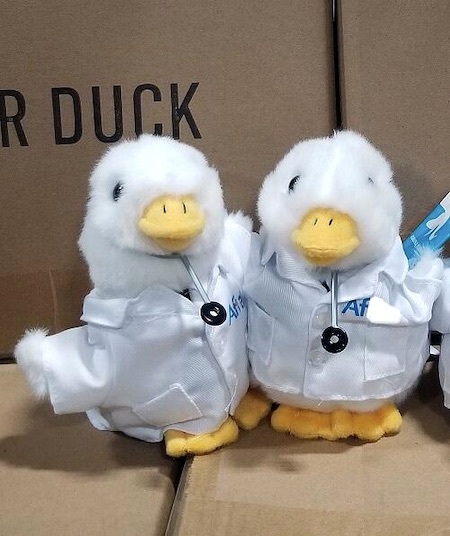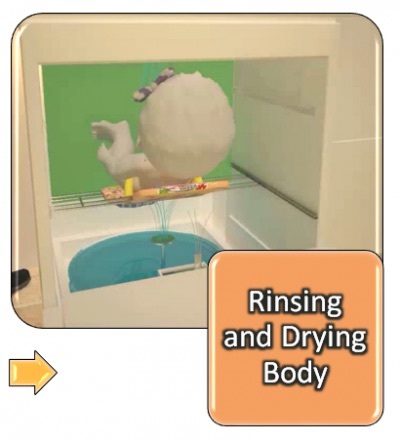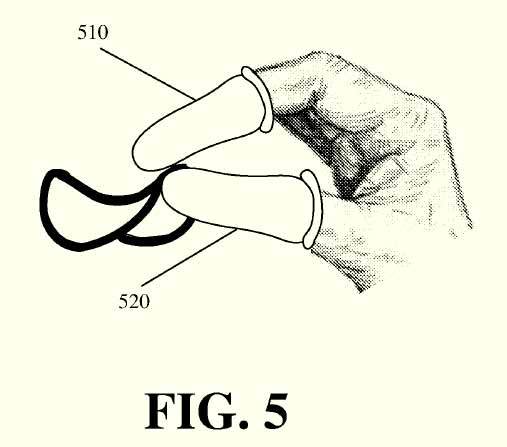Marc Abrahams's Blog, page 117
May 18, 2020
Finger-Food Hygiene Attachments [new patent]
US-based inventor Peter Delgrosso points out that consuming finger foods can sometimes be a hygienically suboptimal process – with a (timely) reminder that, in the act of eating finger foods ;
“Germs, bacteria, and other harmful elements (e.g., microorganisms, viruses, chemicals, etc.) on our hands and fingers can then make their way into the body.”
“There is therefore a need to provide a way with which to consume finger foods as intended without the accompanying hygiene and cleanliness issues. Specifically, there is a need to allow consumers the ability to use their fingers when eating finger foods without having to wash their hands before eating because of concern for ingesting harmful elements, and also after eating because residual elements transferred from the finger foods to consumer’s fingers.”
See : ‘Finger Sheaths’ , United States Patent 10,645,983, May 12, 2020
Note: Readers may spot some similarities with another US patent, issued a couple of months ago, see: Fingers-Only Glove [new patent]
Research research by Martin Gardiner

May 16, 2020
Pocket-Sized #1008: “Horse Calculus”
Horse Calculus
In this Pocket-Sized episode #1008, Marc Abrahams shows an unusual research study to Mason Porter. Dramatic readings and reactions ensue.
The research mentioned in this episode is featured in the special Mathematics issue (Vol. 16, #4) of the Annals of Improbable Research Magazine.

Remember, our Patreon donors, on most levels, get access to each podcast episode before it is made public.
1. Mason Porter encounters:
“Horse Calculus,” Michael Berry, Annals of Improbable Research, vol. 16, no. 4, July-August 2010, pp. 10-11.
“Determination of the Resultant Dipole of the Heart from Measurements on the Heart Surface,” D. Gabor and C.V. Nelson, Journal of Applied Physics, vol. 25, 1954, pp. 413-6.
“Studies on the Equine Cardiac Electric Field. I. Body Surface Potentials, II. The Integration of Body Surface Potentials to Derive Resultant Cardiac Dipole Moments,” P.G.G. Darke and J.R. Holmes, Journal of Electrocardiology, vol. 2, 1969, pp. 222-234 and 235-244.
Seth Gliksman, Production Assistant
Available on Spotify, Apple Podcasts, Overcast, Google Podcasts, AntennaPod, BeyondPod and elsewhere!

May 15, 2020
Searching in the Weeds for a Cannabis Treatment for Covid-19
Almost every surprising discovery comes from something that seemed unlikely—the seeming-unlikeliness is why the discovery had to be discovered surprisingly. Here is one of many new attempts to discover something that would surprise and delight the world. This particular discovery, should it be discovered, would theoretically infuriate a few people.
“In Search of Preventative Strategies: Novel Anti-Inflammatory High-CBD Cannabis Sativa Extracts Modulate ACE2 Expression in COVID-19 Gateway Tissues,” Bo Wang, Anna Kovalchuk, Dongping Li, Yaroslav Ilnytskyy, Igor Kovalchuk, and Olga Kovalchuk [pictured here], Preprints 2020, 2020040315. The authors, at the University of Lethbridge and the University of Calgary, Canada, explain:
 Olga Kovalchuk
Olga KovalchukWith the rapidly growing pandemic of COVID-19 caused by the new and challenging to treat zoonotic SARS-CoV2 coronavirus, there is an urgent need for new therapies and prevention strategies that can help curtail disease spread and reduce mortality….
Cannabis sativa, especially one high in the anti-inflammatory cannabinoid cannabidiol (CBD), has been proposed to modulate gene expression and inflammation and harbour anti-cancer and anti-inflammatory properties. Working under the Health Canada research license, we have developed over 800 new Cannabis sativa lines and extracts and hypothesized that high-CBD C. sativa extracts may be used to modulate ACE2 expression in COVID-19 target tissues. Screening C. sativa extracts using artificial human 3D models of oral, airway, and intestinal tissues, we identified 13 high CBD C. sativa extracts that modulate ACE2 gene expression and ACE2 protein levels.

May 14, 2020
Another incident with lead in ducks
Heavy-leaded ducks were seized by the US Customs and Border Protection agency, an action the agency announced in a May 12, 2020 press release:
U.S. Customs and Border Protection (CBP) officers at the Savannah Seaport seized 5,000 stuffed toy ducks after it was determined that they contained excessive amounts of lead.
The press release includes this photo:

Noted New York City customs attorney William J. Maloney commented on this, to us: “Inspectors will pull toy samples to check for lead and other CPSC issues. Lead paint on toys from China used to be pretty common. They could also have had a tip or prior problem. It was the lead that led to the seizure. A good catch.”
Lead in Ducks, Uranium in Ducks
There has in the past been concern about lead in non-toy ducks. Uranium was proposed as a less-harmful alternative. We wrote about this some years ago:
Depleted uranium should, perhaps, be the ammunition of choice for duck hunters. That’s the conclusion of a study called Response of American Black Ducks to Dietary Uranium: A Proposed Substitute for Lead Shot.
The recommendation, published in 1983 in the Journal of Wildlife Management, has not been much disputed. The study’s authors, biologists Susan Haseltine and Louis Sileo, were based at the Patuxent Wildlife Research Centre in Laurel, Maryland.
Lead shot is dangerous for ducks, especially if it hits them. When it doesn’t hit a duck (or another hunter, as sometimes happens), the shot falls into the wetlands. The lead leaches into the muck, slowly poisoning any ducks that have managed to avoid being shot….
We then prepared a video version of that report about the duck-lead-uranium report (the short video also includes, for variety, Jill Lepore‘s 24/7 Lecture on the topic “History”):

May 13, 2020
Podcast Episode #210: “Famous Monks with Bad Breath”
Famous Monks with Bad Breath, Porn Research, Icky Cutesy Research Review, Missing Pieces Research Review, Amorous Ostriches and Exposure at Sea, and The Plastic Pink Flamingo.
In episode #210, Marc Abrahams shows some unfamiliar research studies to Jean Berko Gleason, Melissa Franklin, and Richard Baguley. Dramatic readings and reactions ensue.
This episode was also aided and perhaps abetted by the folks at Archie McPhee, who host their own podcast called “Less Talk, More Monkey”.
Remember, our Patreon donors, on most levels, get access to each podcast episode before it is made public.
1. Jean Berko Gleason encounters:
Statheropoulos, M., A. Agapiou, and A. Georgiadou (2006). ‘Analysis of Expired Air of Fasting Male Monks at Mount Athos.’ Journal of Chromatography B 832: 274–79.
Mitsikostas, D. D., A. Thomas, S. Gatzonis, A. Ilias, and C. Papageorgiou. (1994). ‘An Epidemiological Study of Headache Among the Monks of Athos (Greece).’ Headache 34 (9): 539–41.
2. Melissa Franklin encounters:
“Relative Alpha Desynchronization and Synchronization During Perception of Music,” C.M. Krause, B. Pörn, A.H. Lang, and M. Laine, Scandinavian Journal of Psychology, vol. 40, no. 3, September 1999, pp. 209-15.
“Convexification of Different Classes of Non-Convex MINLP Problems,” R. Pörn, I. Harjunkoski, and T. Westerlund, Computers and Chemical Engineering, vol. 23, no. 3, February 28, 1999, pp. 439-48.
“The Two-Stage Bayesian Method Used For the T-Book Application,” K. Pörn, Reliability Engineering and System Safety, vol. 51, no. 2, February 1996, pp. 169-79.
“Health and Adaptedness,” I. Pörn, Theoretical Medicine, vol. 14, no. 4, December 1993, pp. 295-303.
“Reversible Effects of Sphingomyelin Degradation on Cholesterol Distribution and Metabolism in Fibroblasts and Transformed Neuroblastoma-Cells,” M.I. Pörn and J.P. Slotte, Biochemical Journal, vol. 271, no.1, October 1, 1990, pp. 121-6.
“Kierkegaard and the Study of the Self,” I. Pörn, Inquiry, vol. 27, nos. 2-3, 1984, pp. 199-205.
3. Jean Berko Gleason encounters:
“Descartes and the Gut: ‘I’m Pink Therefore I Am,’“ D.G. Thompson, Gut, vol. 49, no. 2, August 2001, pp. 165-6.
“Gastrointestinal: Intrathoracic Upside-Down Stomach,” Y. Fujiwara, K. Higuchi, and T. Arakawa, Journal of Gastroenterology and Hepatology, vol. 16, no. 7, July 2001, p. 823.
“Vomit Identification By a Pepsin Assay Using a Fibrin Blue-Agarose Gel Plate,” S. Yamada, et al., Forensic Science International, vol. 52, no. 2, January 1992, pp. 215-21.
“A Partially Mummified Corpse With Pink Teeth and Pink Nails,” C. Ortmann and A. DuChesne, International Journal of Legal Medicine, vol. 111, no. 1, 1998, pp. 35-7.
4. Richard Baguley encounters:
“Social Perceptions of Individuals Missing Upper Front Teeth,” Mary S. Willis, Cynthia Willis-Esqueda, and Ryan N. Schacht, Perceptual and Motor Skills, vol. 106, no. 2, April 2008, pp. 423–35.
“The Effect of Broken Exhibits on the Experiences of Visitors at a Science Museum,” Elizabeth Kunz Kollmann, Visitor Studies, vol. 10, no. 2, October 2007, pp. 178–91.
“The Missing Bones of Thersites: A Note on Iliad 2.212-19,” R. Clinton Simms, American Journal of Philology, vol. 126, no. 1, Spring 2005, pp. 33–40.
“The Mystery of the Missing Toes: Extreme Levels of Natural Mutilation in Island Lizard Populations,” Bart Vervust, Stefan Van Dongen, Irena Grbac, and Raoul Van Damme. Functional Ecology, vol. 23, no. 5, October 2009, pp. 996–1003.
“Automated Solutions to Incomplete Jigsaw Puzzles,” Robert Tybon and Don Kerr, Artificial Intelligence Review, vol. 32, nos. 1–4, 2009, pp. 77–99.
5. Jean Berko Gleason encounters:
Bubier, N. E., C. G. M. Paxton, P. Bowers, and D. C. Deeming. “Courtship behaviour of ostriches (Struthio camelus) towards humans under farming conditions in Britain.” British poultry science 39, no. 4 (1998): 477-481.
Paxton, C. G. M., Erik Knatterud, and Sharon L. Hedley (2005). ‘Cetaceans, Sex and Sea Serpents: An Analysis of the Egede Accounts of a “Most Dreadful Monster” Seen Off the Coast of Greenland in 1734.’ Archives of Natural History 32 (1): 1–9.
6. Marc Abrahams encounters:
Interview with Archie McPhee founder Mark Pahlow about Ig Nobel Prize winner Don Featherstone, creator of the plastic pink flamingo.
Bruce Petschek, Audio Engineer
Jon Shedler, Audio Engineer
Seth Gliksman, Production Assistant
Available on Spotify, Apple Podcasts, Overcast, Google Podcasts, AntennaPod, BeyondPod and elsewhere!

May 12, 2020
What is it like to be a (drunken) bat? [two studies]
 Driving whilst under the influence of alcohol is widely regarded as dangerous. So, perhaps flying whilst intoxicated, if you’re, say, a fruit bat, might be unwise too? Two scientific research groups have experimentally tested the flying performance of fruit bats whilst tipsy (the bats, not the researchers). But the results are, if not contradictory, somewhat conflicting.
Driving whilst under the influence of alcohol is widely regarded as dangerous. So, perhaps flying whilst intoxicated, if you’re, say, a fruit bat, might be unwise too? Two scientific research groups have experimentally tested the flying performance of fruit bats whilst tipsy (the bats, not the researchers). But the results are, if not contradictory, somewhat conflicting.
The first, a Canadian study published in Feb. 2010, found that bats which had been drinking didn’t appear to have significant problems flying and echolocating.
“We fed wild caught Artibeus jamaicensis, A. lituratus, A. phaeotis, Carollia sowelli, Glossophaga soricina, and Sturnira lilium (Chiroptera, Phyllostomidae) sugar water (44 g of table sugar in 500 ml of water) or sugar water with ethanol before challenging them to fly through an obstacle course while we simultaneously recorded their echolocation calls. We used bat saliva, a non-invasive proxy, to measure blood ethanol concentrations ranging from 0 to >0.3% immediately before flight trials. Flight performance and echolocation behaviour were not significantly affected by consumption of ethanol, but species differed in their blood alcohol concentrations after consuming it.”
See: Drinking and Flying: Does Alcohol Consumption Affect the Flight and Echolocation Performance of Phyllostomid Bats? PLOS ONE, February 1, 2010
But a second study, published later that same year, found that inebriated bats’ echolocation skills were considerably affected by alcohol.
“[…] we hypothesized that, if ingested, food containing >1% ethanol is toxic to these [fruit] bats, probably causing inebriation that will affect flight and echolocation skills. We tested this hypothesis by flying Egyptian fruit bats in an indoor corridor and found that after ingesting ethanol-rich food bats flew significantly slower than when fed ethanol-free food. Also, the ingestion of ethanol significantly affected several variables of the bats’ echolocation calls and behavior.”
See: Ethanol ingestion affects flight performance and echolocation in Egyptian fruit bats , Behavioural Processes, Volume 84, Issue 2, June 2010, Pages 555-558
Note: As far as can be ascertained, no subsequent studies have resolved answers to the question.
BONUS : What is it like to be a bat? by philosopher Thomas Nagel, The Philosophical Review, LXXXIII, 4 (October 1974): 435-50.
Photo courtesy Trikansh sharma, . at Wikipedia.
Research research by Martin Gardiner

May 11, 2020
A Bulgarian Museum Savoring of the Ig Nobel Prize
The Bulgarian National Museum of Natural History podcast takes a long, loving look at many of the past Ig Nobel Prize winners.

May 9, 2020
Pocket-Sized #1007: “Bereitschaftspotential”
Bereitschaftspotential
In this Pocket-Sized episode #1007, Marc Abrahams shows an unfamiliar research study to Jean Berko Gleason. Dramatic readings and reactions ensue.
The research mentioned in this episode is featured in the special Psychology issue (vol. 26, #1) of the Annals of Improbable Research magazine.

Remember, our Patreon donors, on most levels, get access to each podcast episode before it is made public.
1. Jean Berko Gleason encounters:
“To Jump or Not to Jump—The Bereitschaftspotential Required to Jump into 192-Meter Abyss,” M. Nann, L.G. Cohen, L. Deecke, and S.R. Soekadar, Scientific Reports, vol. 9, no. 1, 2019.
Seth Gliksman, Production Assistant
Available on Spotify, Apple Podcasts, Overcast, Google Podcasts, AntennaPod, BeyondPod and elsewhere!

May 8, 2020
The automatic diaper-changing machine is now in development
BabyWasher, the automatic dirty-diaper-changing invention, honored by the 2019 Ig Nobel Prize for engineering, now has a name, and is now undergoing intense development. You can follow the progress by visiting the inventor’s new web site, BabyWashers.com.



The BabyWashers site explains:
What Does BabyWasher Do?
After placing the baby in the BabyWasher’s chair and pressing the start button, the device removes the dirty diaper from the baby’s body, washes and dries the lower body, then places the new diaper on the baby’s body. All of these steps do automatically.

May 7, 2020
Pocket-Sized #1006: “Hot Sauce Aggression”
Hot Sauce Aggression
In this Pocket-Sized episode #1006, Marc Abrahams shows an unfamiliar research study to Dany Adams. Dramatic readings and reactions ensue.
The research mentioned in this episode is featured in the special Ig: the Triumph of Miss Sweetie Poo issue (Vol. 7, #1) of the Annals of Improbable Research Magazine.

Remember, our Patreon donors, on most levels, get access to each podcast episode before it is made public.
1. Dany Adams encounters:
“A Hot New Way to Measure Aggression: Hot Sauce Allocation,” Joel D. Lieberman, Sheldon Solomon, Jeff Greenberg, and Holly A. McGregor, Aggressive Behavior, vol. 25, 1999, pp. 331–348.
Seth Gliksman, Production Assistant
Available on Spotify, Apple Podcasts, Overcast, Google Podcasts, AntennaPod, BeyondPod and elsewhere!

Marc Abrahams's Blog
- Marc Abrahams's profile
- 14 followers




